service interval CHEVROLET KODIAK 2007 Owners Manual
[x] Cancel search | Manufacturer: CHEVROLET, Model Year: 2007, Model line: KODIAK, Model: CHEVROLET KODIAK 2007Pages: 430, PDF Size: 6.06 MB
Page 301 of 430
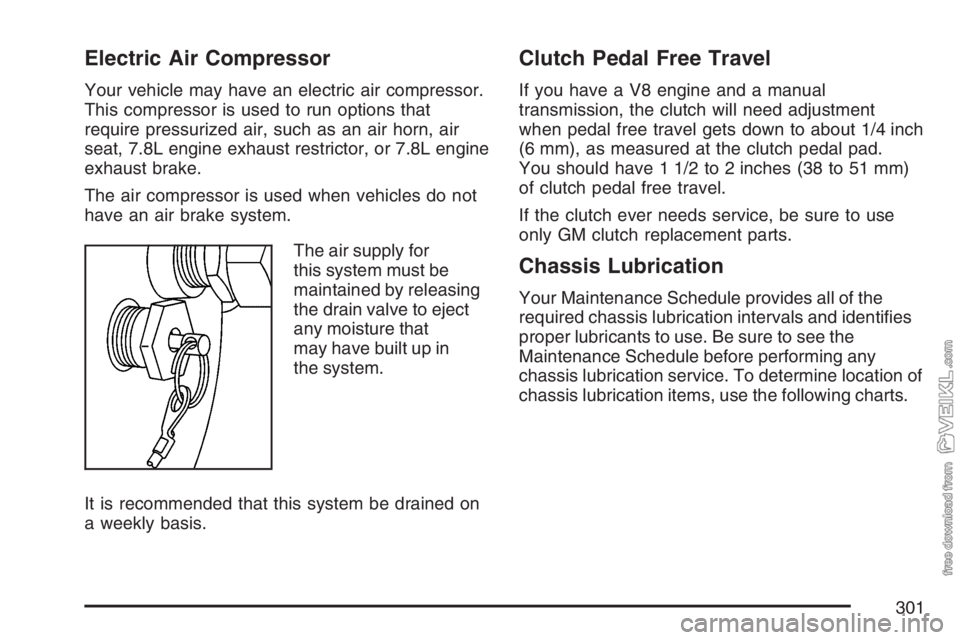
Electric Air Compressor
Your vehicle may have an electric air compressor.
This compressor is used to run options that
require pressurized air, such as an air horn, air
seat, 7.8L engine exhaust restrictor, or 7.8L engine
exhaust brake.
The air compressor is used when vehicles do not
have an air brake system.
The air supply for
this system must be
maintained by releasing
the drain valve to eject
any moisture that
may have built up in
the system.
It is recommended that this system be drained on
a weekly basis.
Clutch Pedal Free Travel
If you have a V8 engine and a manual
transmission, the clutch will need adjustment
when pedal free travel gets down to about 1/4 inch
(6 mm), as measured at the clutch pedal pad.
You should have 1 1/2 to 2 inches (38 to 51 mm)
of clutch pedal free travel.
If the clutch ever needs service, be sure to use
only GM clutch replacement parts.
Chassis Lubrication
Your Maintenance Schedule provides all of the
required chassis lubrication intervals and identifies
proper lubricants to use. Be sure to see the
Maintenance Schedule before performing any
chassis lubrication service. To determine location of
chassis lubrication items, use the following charts.
301
Page 317 of 430
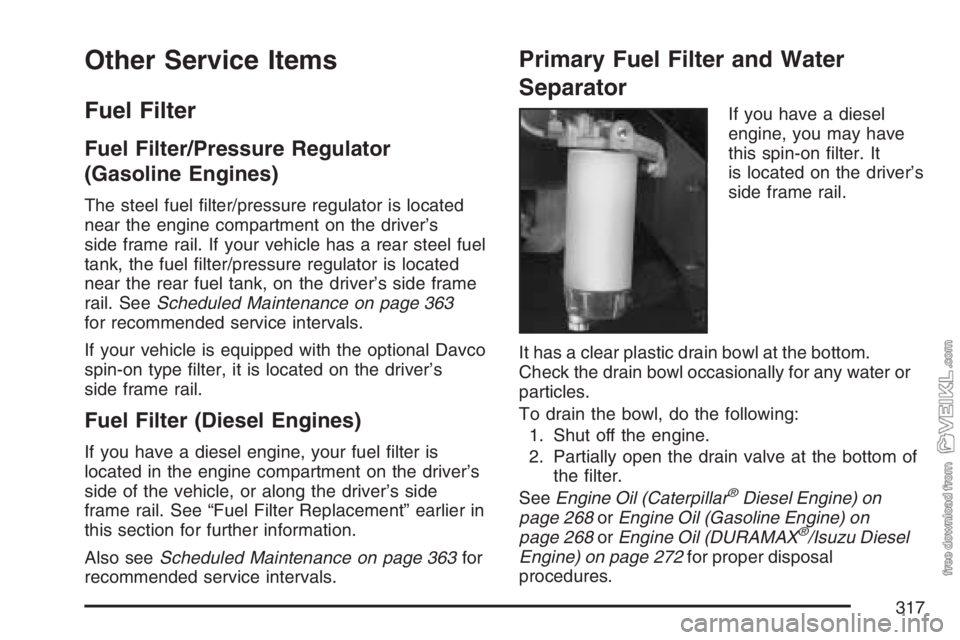
Other Service Items
Fuel Filter
Fuel Filter/Pressure Regulator
(Gasoline Engines)
The steel fuel filter/pressure regulator is located
near the engine compartment on the driver’s
side frame rail. If your vehicle has a rear steel fuel
tank, the fuel filter/pressure regulator is located
near the rear fuel tank, on the driver’s side frame
rail. SeeScheduled Maintenance on page 363
for recommended service intervals.
If your vehicle is equipped with the optional Davco
spin-on type filter, it is located on the driver’s
side frame rail.
Fuel Filter (Diesel Engines)
If you have a diesel engine, your fuel filter is
located in the engine compartment on the driver’s
side of the vehicle, or along the driver’s side
frame rail. See “Fuel Filter Replacement” earlier in
this section for further information.
Also seeScheduled Maintenance on page 363for
recommended service intervals.
Primary Fuel Filter and Water
Separator
If you have a diesel
engine, you may have
this spin-on filter. It
is located on the driver’s
side frame rail.
It has a clear plastic drain bowl at the bottom.
Check the drain bowl occasionally for any water or
particles.
To drain the bowl, do the following:
1. Shut off the engine.
2. Partially open the drain valve at the bottom of
the filter.
SeeEngine Oil (Caterpillar
®Diesel Engine) on
page 268orEngine Oil (Gasoline Engine) on
page 268orEngine Oil (DURAMAX
®/Isuzu Diesel
Engine) on page 272for proper disposal
procedures.
317
Page 360 of 430
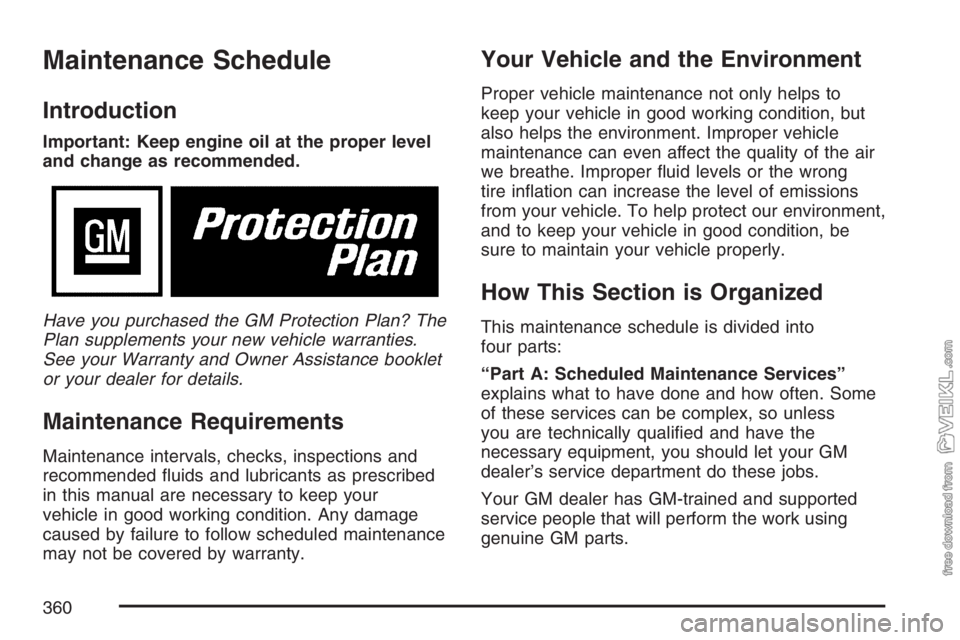
Maintenance Schedule
Introduction
Important: Keep engine oil at the proper level
and change as recommended.
Have you purchased the GM Protection Plan? The
Plan supplements your new vehicle warranties.
See your Warranty and Owner Assistance booklet
or your dealer for details.
Maintenance Requirements
Maintenance intervals, checks, inspections and
recommended fluids and lubricants as prescribed
in this manual are necessary to keep your
vehicle in good working condition. Any damage
caused by failure to follow scheduled maintenance
may not be covered by warranty.
Your Vehicle and the Environment
Proper vehicle maintenance not only helps to
keep your vehicle in good working condition, but
also helps the environment. Improper vehicle
maintenance can even affect the quality of the air
we breathe. Improper fluid levels or the wrong
tire inflation can increase the level of emissions
from your vehicle. To help protect our environment,
and to keep your vehicle in good condition, be
sure to maintain your vehicle properly.
How This Section is Organized
This maintenance schedule is divided into
four parts:
“Part A: Scheduled Maintenance Services”
explains what to have done and how often. Some
of these services can be complex, so unless
you are technically qualified and have the
necessary equipment, you should let your GM
dealer’s service department do these jobs.
Your GM dealer has GM-trained and supported
service people that will perform the work using
genuine GM parts.
360
Page 362 of 430
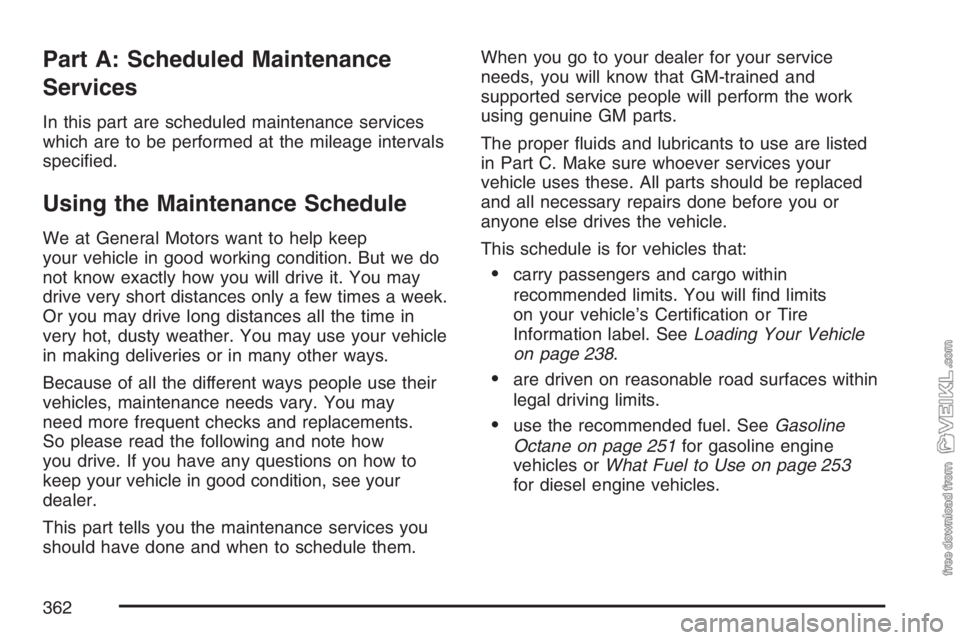
Part A: Scheduled Maintenance
Services
In this part are scheduled maintenance services
which are to be performed at the mileage intervals
specified.
Using the Maintenance Schedule
We at General Motors want to help keep
your vehicle in good working condition. But we do
not know exactly how you will drive it. You may
drive very short distances only a few times a week.
Or you may drive long distances all the time in
very hot, dusty weather. You may use your vehicle
in making deliveries or in many other ways.
Because of all the different ways people use their
vehicles, maintenance needs vary. You may
need more frequent checks and replacements.
So please read the following and note how
you drive. If you have any questions on how to
keep your vehicle in good condition, see your
dealer.
This part tells you the maintenance services you
should have done and when to schedule them.When you go to your dealer for your service
needs, you will know that GM-trained and
supported service people will perform the work
using genuine GM parts.
The proper fluids and lubricants to use are listed
in Part C. Make sure whoever services your
vehicle uses these. All parts should be replaced
and all necessary repairs done before you or
anyone else drives the vehicle.
This schedule is for vehicles that:
•carry passengers and cargo within
recommended limits. You will find limits
on your vehicle’s Certification or Tire
Information label. SeeLoading Your Vehicle
on page 238.
•are driven on reasonable road surfaces within
legal driving limits.
•use the recommended fuel. SeeGasoline
Octane on page 251for gasoline engine
vehicles orWhat Fuel to Use on page 253
for diesel engine vehicles.
362
Page 363 of 430
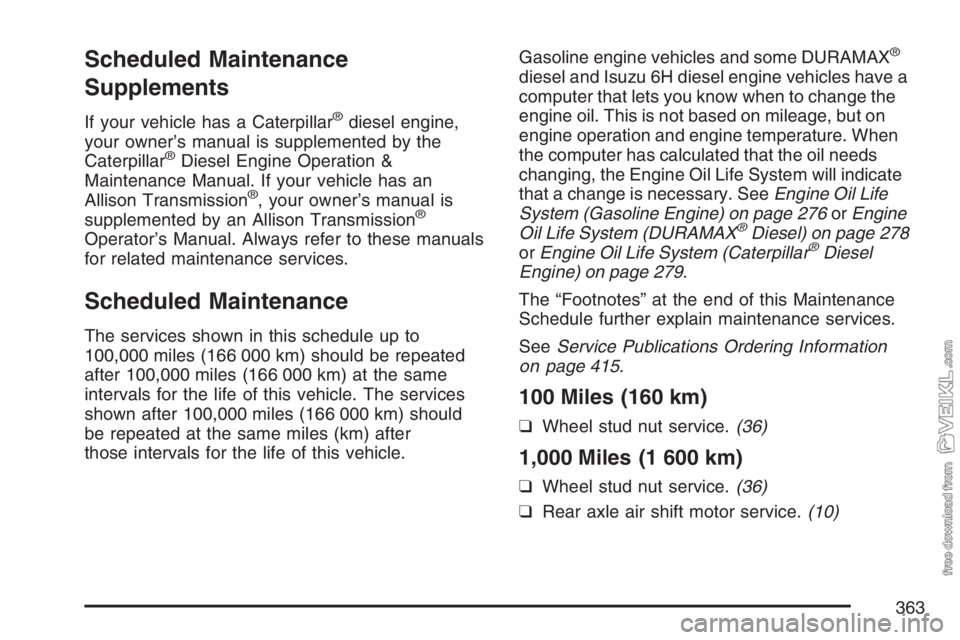
Scheduled Maintenance
Supplements
If your vehicle has a Caterpillar®diesel engine,
your owner’s manual is supplemented by the
Caterpillar
®Diesel Engine Operation &
Maintenance Manual. If your vehicle has an
Allison Transmission
®, your owner’s manual is
supplemented by an Allison Transmission®
Operator’s Manual. Always refer to these manuals
for related maintenance services.
Scheduled Maintenance
The services shown in this schedule up to
100,000 miles (166 000 km) should be repeated
after 100,000 miles (166 000 km) at the same
intervals for the life of this vehicle. The services
shown after 100,000 miles (166 000 km) should
be repeated at the same miles (km) after
those intervals for the life of this vehicle.Gasoline engine vehicles and some DURAMAX
®
diesel and Isuzu 6H diesel engine vehicles have a
computer that lets you know when to change the
engine oil. This is not based on mileage, but on
engine operation and engine temperature. When
the computer has calculated that the oil needs
changing, the Engine Oil Life System will indicate
that a change is necessary. SeeEngine Oil Life
System (Gasoline Engine) on page 276orEngine
Oil Life System (DURAMAX
®Diesel) on page 278
orEngine Oil Life System (Caterpillar®Diesel
Engine) on page 279.
The “Footnotes” at the end of this Maintenance
Schedule further explain maintenance services.
SeeService Publications Ordering Information
on page 415.
100 Miles (160 km)
❑Wheel stud nut service.(36)
1,000 Miles (1 600 km)
❑Wheel stud nut service.(36)
❑Rear axle air shift motor service.(10)
363
Page 383 of 430
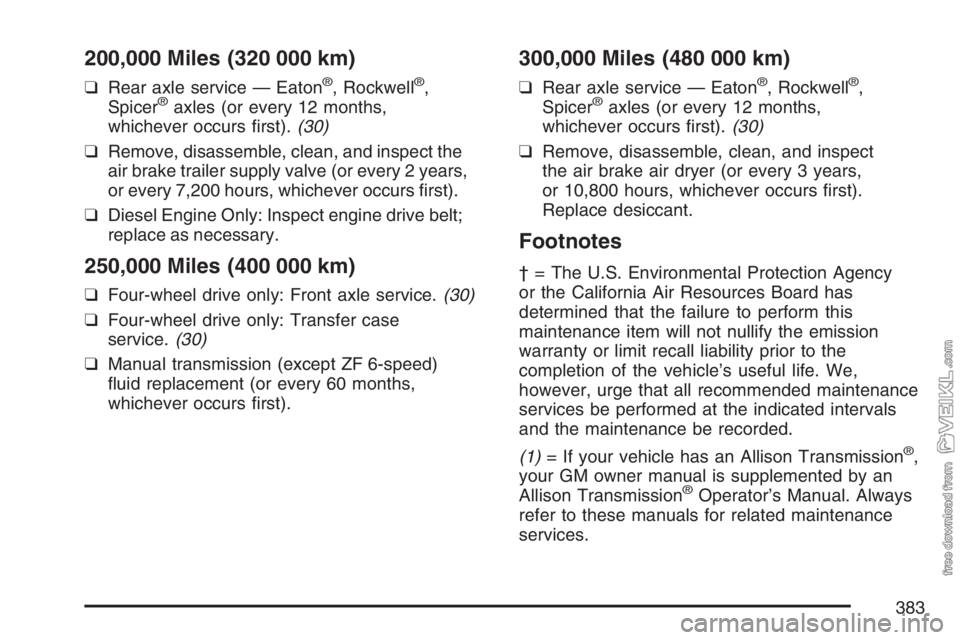
200,000 Miles (320 000 km)
❑Rear axle service — Eaton®, Rockwell®,
Spicer®axles (or every 12 months,
whichever occurs first).(30)
❑Remove, disassemble, clean, and inspect the
air brake trailer supply valve (or every 2 years,
or every 7,200 hours, whichever occurs first).
❑Diesel Engine Only: Inspect engine drive belt;
replace as necessary.
250,000 Miles (400 000 km)
❑Four-wheel drive only: Front axle service.(30)
❑Four-wheel drive only: Transfer case
service.(30)
❑Manual transmission (except ZF 6-speed)
fluid replacement (or every 60 months,
whichever occurs first).
300,000 Miles (480 000 km)
❑Rear axle service — Eaton®, Rockwell®,
Spicer®axles (or every 12 months,
whichever occurs first).(30)
❑Remove, disassemble, clean, and inspect
the air brake air dryer (or every 3 years,
or 10,800 hours, whichever occurs first).
Replace desiccant.
Footnotes
† = The U.S. Environmental Protection Agency
or the California Air Resources Board has
determined that the failure to perform this
maintenance item will not nullify the emission
warranty or limit recall liability prior to the
completion of the vehicle’s useful life. We,
however, urge that all recommended maintenance
services be performed at the indicated intervals
and the maintenance be recorded.
(1)= If your vehicle has an Allison Transmission
®,
your GM owner manual is supplemented by an
Allison Transmission
®Operator’s Manual. Always
refer to these manuals for related maintenance
services.
383
Page 388 of 430
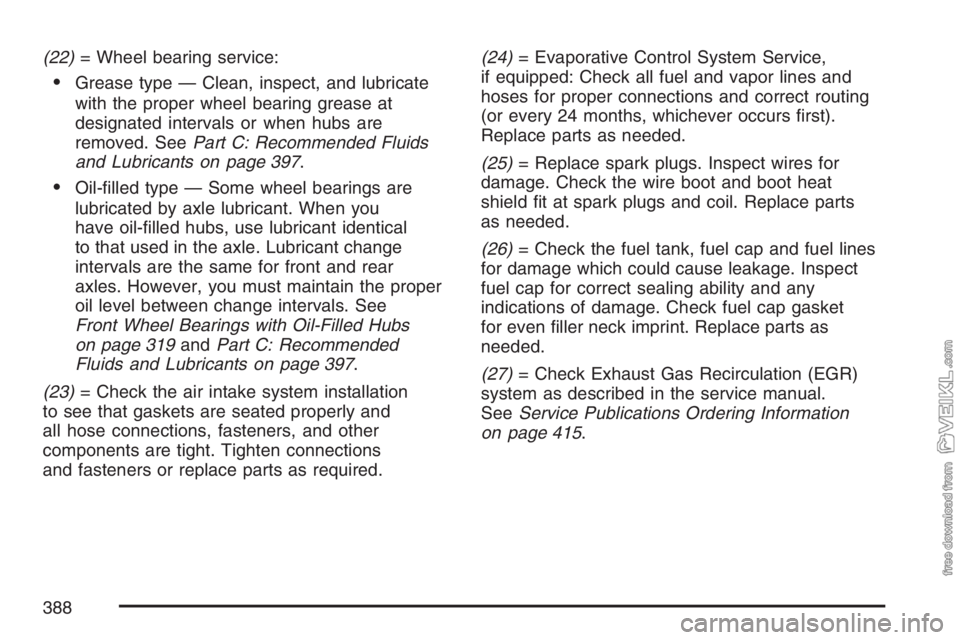
(22)= Wheel bearing service:
•Grease type — Clean, inspect, and lubricate
with the proper wheel bearing grease at
designated intervals or when hubs are
removed. SeePart C: Recommended Fluids
and Lubricants on page 397.
•Oil-filled type — Some wheel bearings are
lubricated by axle lubricant. When you
have oil-filled hubs, use lubricant identical
to that used in the axle. Lubricant change
intervals are the same for front and rear
axles. However, you must maintain the proper
oil level between change intervals. See
Front Wheel Bearings with Oil-Filled Hubs
on page 319andPart C: Recommended
Fluids and Lubricants on page 397.
(23)= Check the air intake system installation
to see that gaskets are seated properly and
all hose connections, fasteners, and other
components are tight. Tighten connections
and fasteners or replace parts as required.(24)= Evaporative Control System Service,
if equipped: Check all fuel and vapor lines and
hoses for proper connections and correct routing
(or every 24 months, whichever occurs first).
Replace parts as needed.
(25)= Replace spark plugs. Inspect wires for
damage. Check the wire boot and boot heat
shield fit at spark plugs and coil. Replace parts
as needed.
(26)= Check the fuel tank, fuel cap and fuel lines
for damage which could cause leakage. Inspect
fuel cap for correct sealing ability and any
indications of damage. Check fuel cap gasket
for even filler neck imprint. Replace parts as
needed.
(27)= Check Exhaust Gas Recirculation (EGR)
system as described in the service manual.
SeeService Publications Ordering Information
on page 415.
388
Page 389 of 430
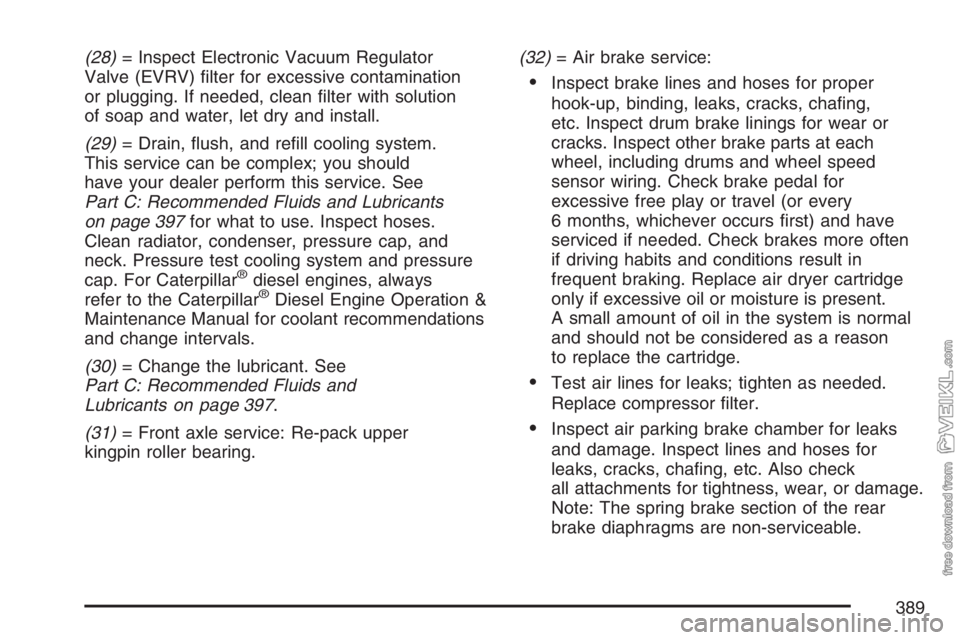
(28)= Inspect Electronic Vacuum Regulator
Valve (EVRV) filter for excessive contamination
or plugging. If needed, clean filter with solution
of soap and water, let dry and install.
(29)= Drain, flush, and refill cooling system.
This service can be complex; you should
have your dealer perform this service. See
Part C: Recommended Fluids and Lubricants
on page 397for what to use. Inspect hoses.
Clean radiator, condenser, pressure cap, and
neck. Pressure test cooling system and pressure
cap. For Caterpillar
®diesel engines, always
refer to the Caterpillar®Diesel Engine Operation &
Maintenance Manual for coolant recommendations
and change intervals.
(30)= Change the lubricant. See
Part C: Recommended Fluids and
Lubricants on page 397.
(31)= Front axle service: Re-pack upper
kingpin roller bearing.(32)= Air brake service:
•Inspect brake lines and hoses for proper
hook-up, binding, leaks, cracks, chafing,
etc. Inspect drum brake linings for wear or
cracks. Inspect other brake parts at each
wheel, including drums and wheel speed
sensor wiring. Check brake pedal for
excessive free play or travel (or every
6 months, whichever occurs first) and have
serviced if needed. Check brakes more often
if driving habits and conditions result in
frequent braking. Replace air dryer cartridge
only if excessive oil or moisture is present.
A small amount of oil in the system is normal
and should not be considered as a reason
to replace the cartridge.
•Test air lines for leaks; tighten as needed.
Replace compressor filter.
•Inspect air parking brake chamber for leaks
and damage. Inspect lines and hoses for
leaks, cracks, chafing, etc. Also check
all attachments for tightness, wear, or damage.
Note: The spring brake section of the rear
brake diaphragms are non-serviceable.
389
Page 391 of 430
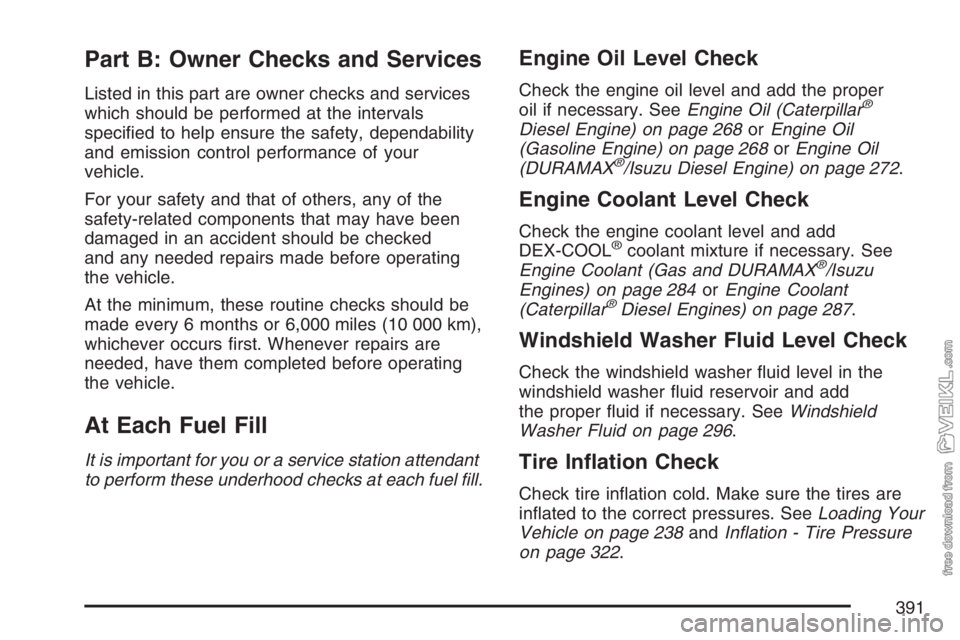
Part B: Owner Checks and Services
Listed in this part are owner checks and services
which should be performed at the intervals
specified to help ensure the safety, dependability
and emission control performance of your
vehicle.
For your safety and that of others, any of the
safety-related components that may have been
damaged in an accident should be checked
and any needed repairs made before operating
the vehicle.
At the minimum, these routine checks should be
made every 6 months or 6,000 miles (10 000 km),
whichever occurs first. Whenever repairs are
needed, have them completed before operating
the vehicle.
At Each Fuel Fill
It is important for you or a service station attendant
to perform these underhood checks at each fuel �ll.
Engine Oil Level Check
Check the engine oil level and add the proper
oil if necessary. SeeEngine Oil (Caterpillar®
Diesel Engine) on page 268orEngine Oil
(Gasoline Engine) on page 268orEngine Oil
(DURAMAX
®/Isuzu Diesel Engine) on page 272.
Engine Coolant Level Check
Check the engine coolant level and add
DEX-COOL®coolant mixture if necessary. See
Engine Coolant (Gas and DURAMAX®/Isuzu
Engines) on page 284orEngine Coolant
(Caterpillar
®Diesel Engines) on page 287.
Windshield Washer Fluid Level Check
Check the windshield washer fluid level in the
windshield washer fluid reservoir and add
the proper fluid if necessary. SeeWindshield
Washer Fluid on page 296.
Tire In�ation Check
Check tire inflation cold. Make sure the tires are
inflated to the correct pressures. SeeLoading Your
Vehicle on page 238andIn�ation - Tire Pressure
on page 322.
391